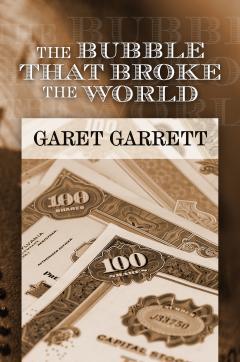More credit is not the panacea for debt! That is the message from Garet Garrett’s 1932 book, the Bubble that Broke the World.

The overuse of debt was a critical cause of the Great Depression (I detailed the other causes here and here). America was a funder of WW1 before entering the war and extended credit egregiously through the 1920s, both publicly and privately. The moral arguments to extend credit were strong. But, in truth, the moral arguments to extend credit always appear strong. Initially a noble war, then reconstruction, then political stability, thereafter to provide European trading partners with credit to purchase US good and services… All seemingly logical arguments but the moral hazard created through the 1920s was insidious. Debt disguised imbalances in Europe, allowed problems to fester, which was a contributing factor towards the depression, eventually culminating in the devastating conflict of WW2.
What are the seemingly morally justifiable credit delusions that we’ve digested in the last 20-30 years? Development financing? Job creation? Job protection? Too big to fail? Infrastructure? Corona healthcare provision? Morally justifiable but dubious long-term solutions. And the evidence is clear; wherever you look, debt continues to grow. 2020 looks like the coronavirus recession but, in reality, the economic problems are over indebtedness. Our ignorance of this truth implies we’re attempting to solve the problem through more debt. Hurray, another similarity to the 1920s.
Don’t get me wrong, I don’t hate debt. Debt is a critical tool in any economy. The key problem during the 1920s/1930s, like today, is that credit, money and interest rates are centralised, not priced by the market. Central banks manipulate interest rates lower, thus credit is extended liberally without adequately accounting for the risk. Under these conditions, bubbles and misallocation build. Interest rate liberalisation would largely negate this problem.
Another interesting insight from Garrett was the change in investment psychology through the 1920s and 1930s. In the 30s investors across the US bought debt instruments which were tied to international financing of European governments. Investors were enticed by the yield with limited consideration of the risk. If there was any doubt, investors were compelled by persuaded morally by the need to re-build European brothers. Post WW1 the US government sold “liberty-bonds” to US citizens to fund European reconstruction. Liberty, haha. The Great Depression, Hilter, Mussolini, Stalin and WW2 aren’t the type of liberty I’d like to invest in.
By the 1930s, the investment psychology had changed.
“What did those people get for their money? They got a promise from people on the other side of the earth. The promise does not mature in time to be kept by the particular members of the group who originally made it. It is a promise designed to be kept by the children of men now living. Yet somehow or other, the banker who offers that bond and the investor who buys that bond rely on the people of Europe taxing themselves a generation from now in order to pay back the principal of that bond to the children of the person who invests in the bonds today. At first blush it is a startling idea.”
We will eventually experience a shift in sentiment as Millennials across the globe contend with the massive debt burden put on their shoulders by their parents. I expect repudiation and default will be common, as we discover our proverbial pyramids.
Egyptian slaves-built pyramids into the sky but were never able to enjoy the fruits of their labour. Garrett argued in the 1930s that there was a new way to command labour & build pyramids, credit. Lowering rates, expanding debt and the size of government leads to investment in numerous useless outcomes, pyramids. The labour represented by this co-opting of resources on false signals is a tragic loss to society. Heart-breaking, but hopefully reason enough to turn the tide against continued debt growth today.
Which modern industries are building pyramids into the sky for the sake of a politician’s pet project? South African taxpayers who’ve repeatedly funded SAA? South African children who’ve suffered through the public education system, funding government education departments and inefficient teachers? American soldiers who’ve died in foreign wars to protect political interests? American Millennial’s who’ve mortgaged their futures on overpriced college education?
Our future won’t look exactly like the 1930’s but our repeated attempts to solve debt with credit implies we’ve got to learn from their mistakes. Politicians ignore the similarities, but we don’t have to. Eventually our economic, financial and social imbalances will find a new equilibrium, but it’ll probably be a painful process to break the relationships of the past 30+ years. Humans are resistant to change. Policy will get radical, power will change hands and psychology could swing in unsurprising ways as the pyramids are eventually uncovered.